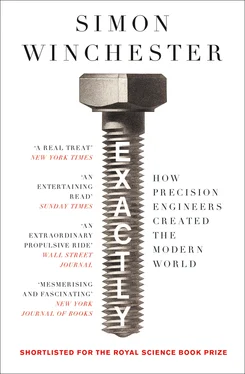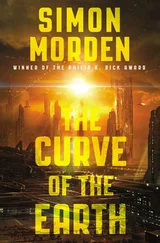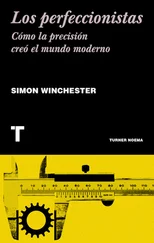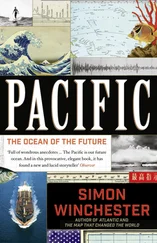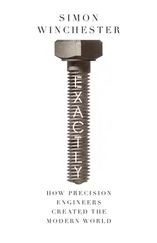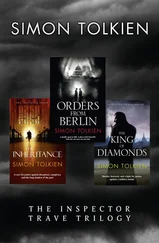Of equally fundamental importance, a lathe so abundantly equipped as Maudslay’s was also able to make that most essential component of the industrialized world, the screw.
Over the centuries, there were many incremental advances in screw making, as we shall see, but it was Henry Maudslay (once he had invented or mastered or improved or in some other manner become intimately associated with the slide rest on his lathe) who then devised a means of cutting metal screws, efficiently, precisely, and fast. Much as Bramah had a lock in his workshop window on Piccadilly, for reasons of pride as much as for his famous challenge, so Maudslay, Sons and Field placed in the bow window of the firm’s first little workshop, on Margaret Street in Marylebone, a single item of which the principal was most proud—and that was a five-foot-long, exactly made, and perfectly straight industrial screw made of brass.
Technically, Maudslay was not the first to perfect a screw-making lathe. Twenty-five years earlier, in 1775, Jesse Ramsden, a scientific instrument maker from Yorkshire who was funded by the same Board of Longitude for which the clockmaker John Harrison had labored, and who was not allowed to patent his invention, had made a small and exquisite screw-cutting lathe. This could cut tiny screws with as many as one hundred twenty-five turns to the inch—meaning it would take one hundred twenty-five turns to advance the screw by one inch—and so would allow the tiniest adjustments to any device to which the screw was harnessed. But Ramsden’s was effectively a one-off machine, as delicate as a watch, meant for work with telescopes and navigational instruments, and in no way destined for the making of large-scale devices made of much metal and that could work at great speed and maintain accuracy and be durable. What Maudslay had done with his fully equipped lathe was to create an engine that, in the words of one historian, would become “the mother tool of the industrial age.”
Moreover, with a screw that was made using his slide rest and his technique, and with a lathe constructed of iron and not with the wooden frame he and Bramah had used initially, he could machine things to a standard of tolerance of one in one ten-thousandth of an inch . Precision was being born before all London’s eyes.
So, whoever did invent the slide rest can take the credit for the later precise manufacture of countless components of every conceivable size and shape and relevance to a million and one machined objects. The slide rest would allow for the making of myriad items, from door hinges to jet engines to cylinder blocks, pistons, and the deadly plutonium cores of atomic bombs—as well as, of course, the screw.
But just who did invent it? Not a few say Henry Maudslay, and that he did so in Joseph Bramah’s “secret workplace [which] contained several curious machines … constructed by Mr. Maudslay with his own hands.” Others say it was Bramah. Still others refute the idea of Maudslay’s involvement entirely, saying definitively that he did not invent it, nor ever claimed to have done so. Encyclopedias say the first slide rest was actually German, having been seen illustrated in a manuscript in 1480. Andrey Nartov, the Russian scientist who had the eighteenth-century title of personal craftsman to Tsar Peter the Great, was revered as the greatest teacher of lathe operation in Europe (and taught the methods to the then-king of Prussia) and is said to have made a working slide rest (and taken it to London to show it off) as early as 1718. And just in case the story from St. Petersburg has any doubters, a Frenchman named Jacques de Vaucanson quite provably made one in 1745.
Chris Evans, a professor in North Carolina who has written extensively about the early years of precision engineering, notes the competing claims, and cautions against the “heroic inventor” treatment of the story. Far better to acknowledge, he says, that precision is a child of many parents, that its advances invariably overlap, that there are a great many indeterminate boundaries between the various disciplines to which the word precision can be attached, and that it was, in its early days, a phenomenon that evolved steadily over three centuries of ever-lessening bewilderment. It is, in other words, a story far less precise than its subject.
That being said, Henry Maudslay’s principal legacy is a wholly memorable one, for other inventions and involvements followed his association with Joseph Bramah, from whose employ he left, in a huff, after his request for a raise—he was making thirty shillings a week in 1797—was turned down too curtly for his taste.
MAUDSLAY PROMPTLY PROCEEDED to free himself from the circumscribed world of West London lock making, and he entered—one might say, he inaugurated—the very different world of mass production. He created in the process the wherewithal for making, in truly massive numbers, a vital component for British sailing ships. He built the wondrously complicated machines that would, for the next one hundred fifty years, make ships’ pulley blocks, the essential parts of a sailing ship’s rigging that helped give the Royal Navy its ability to travel, police, and, for a while, rule the world’s oceans.
This all came about in a moment of the happiest chance, and just as with Bramah and the lock in Piccadilly, it involved a shopwindow (Henry Maudslay’s) and the proud public showroom display of the five-foot-long brass screw Maudslay had made on his lathe and which he had placed there, center stage, as an advertisement of his skills. Soon after he set up the screw display, so naval legend has it, came the serendipitous moment. It involved the two figures who were going to create the pulley block factory, and who vowed to do so properly, to fill an urgent and growing need.
A block-making factory of sorts had already been set up in the southern dock city of Southampton in the mid-eighteenth century, performing some of the sawing and morticing of the wooden parts, but much of the finishing work still had to be done by hand, and in consequence, the supply chain remained unreliable at best. And a reliable supply chain was seen to be vital for England’s survival.
Britain had been at war with France, on and off, for much of the late eighteenth century, and the arrival on the scene of Napoleon Bonaparte in the aftermath of the French Revolution convinced London that her forces needed to be at the ready for much of the early nineteenth century, too. Of the two British fighting forces, the army and the Royal Navy, it was the admirals who took the lion’s share of the war budget, and Britain’s docks were soon bristling with big ships ready to cast off at a moment’s notice to give any French opponents, Napoleon’s especially, a taste of the lash. Shipyards were busy building, dry docks were busy repairing, and the seas from the Channel to the Nile, from the Barbary Coast to Coromandel, were alive with great British men-o’-war, powerful and watchful, ceaselessly on the prowl.
These were, of course, all sailing vessels. Mostly they were enormous craft with wooden hulls and copper-sheathed keels, with three decks ranged with cannon, with enormous masts of Eastern White pine supporting equally vast acreages of canvas sailcloth. And all the sail ware of the time were bolts of canvas suspended, supported, and controlled by way of endless miles of rigging, of stays and yards and shrouds and footropes, most of which had to pass through systems of tough wooden pulleys that were known simply to navy men as blocks—pulley blocks, part of a warship’s arrangements known within and beyond the maritime world as block and tackle.
A large ship might have as many as fourteen hundred pulley blocks, which were of varying types and sizes depending on the task required. A block with a single pulley might be all that was needed to allow a sailor to hoist a topsail, say, or move a single spar from one location to another. The lifting of a very heavy object (an anchor, for example) might need an arrangement of six blocks, each with three sheaves, or pulleys, and with a rope passing through all six such that a single sailor might exert a pull of only a few easy pounds in order to lift an anchor weighing half a ton. Block-and-tackle physics, taught still in some good primary schools, shows how even the most rudimentary pulley system can offer the greatest of mechanical advantage, and combines this power with an equally great degree of simplicity and elegance.
Читать дальше
